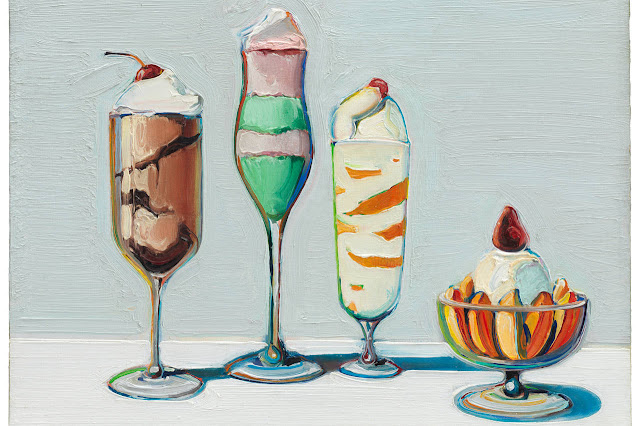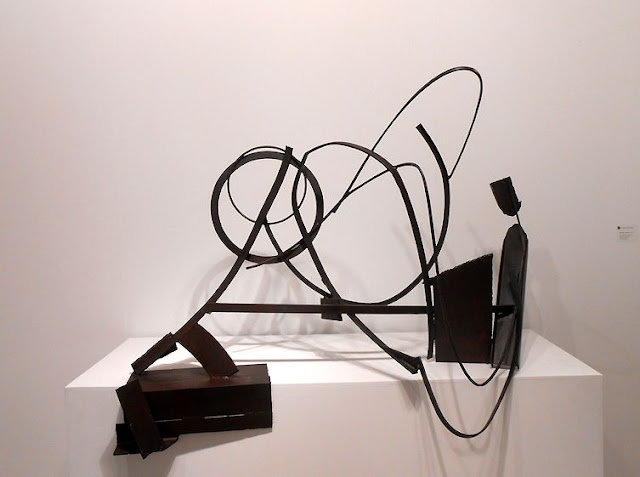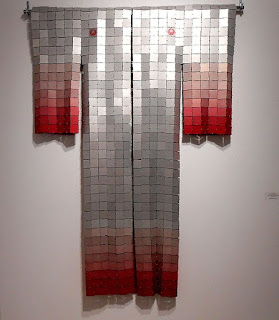Alexander Calder was one of the most popular artists at the fair, with paintings, prints, and
sculpture. "Red and Blue Flowers" was a print.
Jim Dine is a Pop artist from the U.S. Here is one of his variations
on the Venus de Milo entitled "Napoli."
Alexander Calder. "Running Circles." Calder worked half the year in France
and half the year in the U.S.
This is a very unusual piece entitled "Apollo" by Li Hongbo of China. It is about 18 in. high.
Although it looks like marble, i tis actually a stack of pieces of handmade paper glued together
at a point in front and back. A white-gloved attendant will take hold of the figure and bend it
back, showing it opens like a huge folded sheet of paper. This is the third year I have seen
similar figures, and they are incredible. It is called "carved paper."
"Knot" by Gino Miles was one of several of his stainless steel sculptures at the fair.
All are mounted so that they can be turned and you can get many views of the piece.
Alex Katz. "Lilies" U.S. Katz is known for his simplified forms
and large flat areas of color. He was influenced by the
Impressionist and by Abstract Art, although he never
painted in a purely abstract manner.
John Chamberlain took the steel from junk cars and cut it, shaped it,
and painted it, sometimes on a very large scale and other times on a
small scale as here. "Rustle" is about a foot high.
Larry Poons. "Tilt." U.S.
Poons was interested in how colors react with one another and
on the retina of our eyes. Small areas of color and large give a very
different impression.
Bridget Riley from England has been one of the leaders of Op Art for
more than half a century. She is interested in how the optical nerves react
to various sizes and shapes of color meeting.
Peter Anton created "Razzle Dazzle Assortment" of different materials, but all meant to look
as "real" as possible. But these are giant in size (the box is 4 x 6 feet) and made of plastic
and various other materials, all as artificial as the donuts we buy each day.
Lynn Chadwick. "Winged Figures." England. Bronze. 5 ft high
Chadwick's figures are often a combination of bird and human.
Jean Dubuffet. "Blue Tower." France
One day in his Paris studio, Dubuffet was put on hold on the
telephone, and while he waited, he droodled with a couple of ball
point pens on a pad of paper. Later he enlarged these images
in paintings and then in sculpture; this is pained bronze.
Allan d'Arcangelo. "Yellow Post." U.S. Hard Edge Style
Allan d'Arcangelo used highways and roadsigns as inpiration
for many of his works.
Peter Anton. "Holiday Treats." Five feet high/ Mixed media.
This is made of paper and various plastics, painted to look
as real as possible. You want to reach out and try one.
Lino Tagliapietra is the most famous Italian glassblower working in Murano, Venice.
This was one of the vases he had for sale. This began as a bubble of molten glass at
the end of a blowpipe and was gradually blown larger and pulled and stretched
by iron tongs into this flowing shape.
Fernando Botero. "Ballet Dancer." Colombia.
Botero's figures, whether painted or cast in bronze, seem inflated and
impassive.
Fernand Leger. "Parade." France. Cubism.
For a while, Leger created works drawn in black outline and then covered with arbitrary
and abstract areas of color. It created a tension in the shallow space of the painting.
Tom Wesselmann. "Bedroom Series." Pop Art.
Roy Lichtenstein. "Red Sofa." U.S. Pop Art.
Lichtenstein was fascinated by the way comic artists drew and colored, using the
cheapest of materials and techniques. He then adapted these practices (flat areas
of color, hatching to represent shading, strong outlines) to large scale
paintings and sculpture.
Robert Cottingham. "Hot." U.S. Cottingham was a leading member
of the Photo-Realists / Super-realists, who tried to be as "scientific"
as a camera in their painting. Signs particularly appealed to them.
Carlo Cruz-Diez. "Physiochromie 235." Venezuela. Op Art
Cruz-Diez is one of the leading Op Artists in the world, creating works which change
right before your eyes, so you ask just what is it youa re seeing. As you walk by this
painting, wich is 12 feet long, the colors and patterns change right before your eyes.
Andy Warhol. "Mao." U.S. Pop Art.
In Pop Art, all images have equal value - a flower, the dictator of the
largest country on earth, a movie star. And all were mass produced
and seen every day by millions. His art reflected life.
Louise Nevelson. "Wall Piece." Russian/American. Wood. 6 ft high
Nevelson's father owned a lumberyard, and she played with wood pieces
her whole life. As an artist, she created forms which looked like
stage sets, or altars, or icon screens in a Greek Orthodox church.
Robert Indiana. "Bob Dylan Series." U.S.
Each of the small circles recalls an earlier large work he did,
and he comments on the human condition.
Robert Indiana. "Bob Dylan Series." U.S. Pop Art.
Indiana used lettering as a visual technique which made interesting
patterns, but which also looked like advertising, and
whether you wanted to or not, you "read" the words.
This is a sculpture made of 12 kinds of inlaid wood entitled "Serpent" by
Jaehyo Lee from China. It is 7 feet long.
Anthony Caro. "Table Piece." England. Iron.
Caro created abstract works from metal, welding the parts, different from carving wood
or casting bronze. The works often look like a strange calligraphy in space.
Jesus Rafael Soto. "Blue. Red, Black." Venezuela
Soto was interested in perception and worked in op and kinetic art.
Some of these pieces are mounted on pegs and stand out; the lines are
painted. As you move, the painting seems to move.
Jesus Rafael Soto. "Yellow and Black" Venezuela.
Op Art and Kinetic Art. As you walk by the lines seem to shimmer
before your eyes and the rectangles of color seem to shake.
Jesus Rafael Soto. "Hanging." Venezuela.
This piece consists of plastic cords hung in a plastic case.
The cords are painted in three colors and give the illusion of
a ball in the center, although there is none.
Marc Chagall. "The Lovers." French/Russian.
Chagall painted the dreams and memories of his life in a
Russian village before the Revolution and before he fled to France.
Robert Motherwell. "Basque Series." U.S. Abstract Expressionism.
Cleve Gray. "Honolulu."
A veteran of WW II, he came home and studied art, becoming
one of the Abstract Expressionist / Color Field painters.
Gary Lang. "White Circle." U.S. California
Gary Lang’s paintings explore repetition and color – brilliant, nuanced
and jarring. The Tondos, up to thirteen feet in diameter, are painted
in concentric rings of shifting color, sometimes gradual,
sometimes abrupt.
Andy Warhol. "Dollar Sign." U.S. Pop Art.
Warhol made money by making money, literally.
This print was selling for $40,000.
Andy Warhol. "John Wayne." U.S. Pop Art.
Andy Warhol. "Marilyn Monroe." U.S. Pop Art.
Marilyn as a person was manufactured with the hair, lips, and eyebrows.
Warhol treated her image like a brand name product, which could be
seen in every store.
Takashi Murakami of Japan. "Flower Ball." This is a flat lithograph, which has
been drawn to look like a ball, by altering the shapes of the small forms.
He is a part of the very important and popular comic art movement in Japan.
Aisha Miyo of Japan. "Waterfall." 2015
Each year there are more Chinese and Japanese artists represented in the show.
Aisha Miyo of Japan. "Kimono" of anodized platelets pf aluminum.
The traditional garment is interpreted in a totally new material.
___





































































